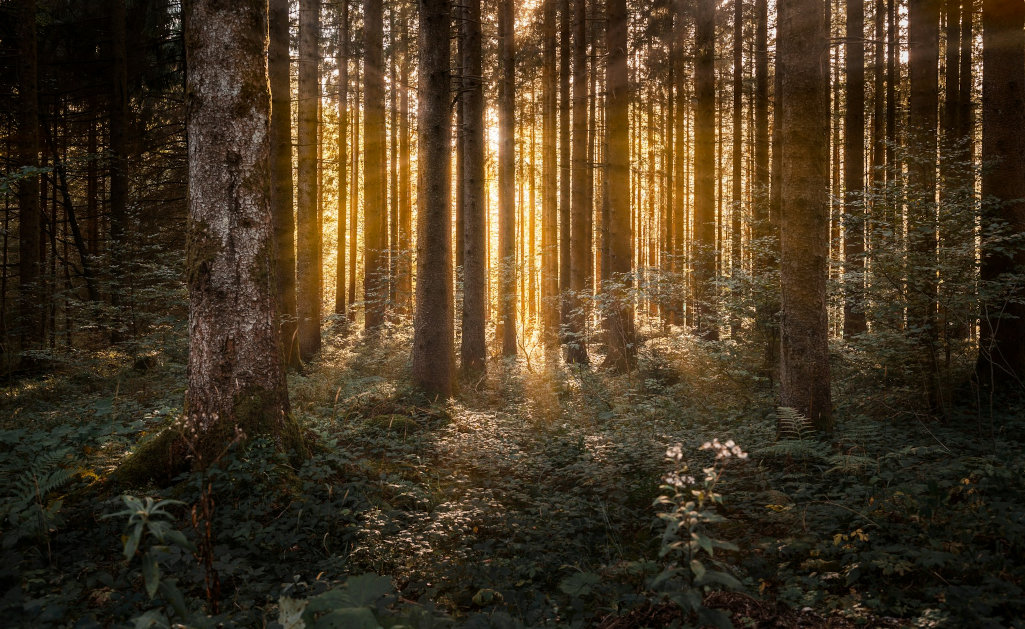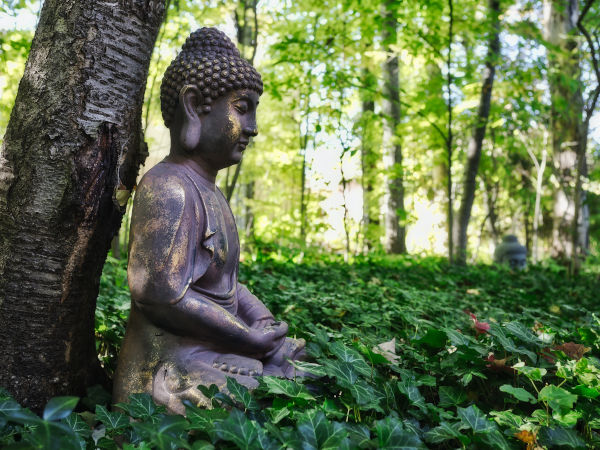Don’t Miss the Forest for the Trees: Forest Therapy as a Spiritual Philosophy
Everyone thinks they know what is nature. Or at least many people believe they do, considering how often we hear the word “nature” being used without hesitation to refer to mountains, lakes, forests, meadows, and the elements found within those spaces. But when I hear of nature used with such casual certainty, part of my me feels the urge to break it all down. Like the force of nature’s storms, I imagine how words can purge our mind’s limitations and disperse new seeds of possibilities so that we can shift our focus away from bounded interpretations of nature to finally remembering what it means to be natural.
I am not an advocate for forest therapy as a nature practice because I feel the pull to do the opposite. I want to remind us that we can trust in life and trust in our nature even when we are not in a forest. Paradoxically, the philosophy that supports forest therapy can help me with this task.
Nature is our interpretation of life
Raymond Williams (1983) has noted that “nature is perhaps the most complex word in the [English] language” (219). In his definition, nature refers to the essence of the world. It is “the essential quality and character of something; […] the inherent force which directs either the world or human beings or both; [and] the material world itself, taken as including or not including human beings.”
The first part of his definition implies that things generally have an essence or a natural tendency. The second part of the definition suggests a teleology that maintains the first part of the definition, that is, the world is directed by a natural force to keep things as they are supposed to be. The third part defines the material world in which the first and second parts are implied to be true. Nowhere in the definition indicate living organisms such as plants and animals or the landscapes inhabited by these organisms, except for the mention of humans.
Yet, in everyday discourse, nature is often described as separate from human civilization. For example, nature is found in the “wilderness” as environments neglected or uninhabited by humans, as environments where animals thrive in natural cycles of procreation and violence, or environments where humans extract time from their busy lives to learn about nature or to relax in it. Alternatively, nature is described as fragments of wilderness found in human environments, for example, as urban forests or songbirds in cities. Even closer to home, nature is life outside of ourselves that we tend to, such as farm animals, pets, or plants in a garden.
Whether human beings and our creations are included in the material world of nature is often the contentious aspect of defining nature. Therefore, nature is a pivotal word in our relationship to language, life, and existence. If nature is considered a resource used for commodities, human beings are consumers. If nature is considered luxury, not every human is worthy of nature. If nature is considered an enemy, humans respond by fear and control. If nature is considered kin, humans are part of an ecological community. If nature is considered home, humans belong in it. How we see nature is how we see ourselves as human beings.

Truth in the forest clearing
Years ago, I told my PhD supervisor that I was interested in becoming what I called an eco-spiritual coach. I don’t remember exactly what I said was my coaching goal but it must have involved the idea of returning home to nature. In response, my supervisor wondered whether the idea would be financially marketable and if people would pay to have someone help them connect with nature.
Flash forward a few years and I’ve since completed training courses in ecopsychology, human design, and forest therapy. I’ve also spent lots of money on coaches and energy healing. I know for certain that people do spend money to help them connect with external nature and internal nature. But the promotional campaigns and narratives around healing are usually simple: you go outdoors because nature-out-there supposedly has healing powers or you heal indoors because your therapist/healer/teacher supposedly has healing knowledge.
But my intuition has a different message: you are the source of your healing power and knowledge, so go where you are supported in your own nature. Outdoor semi-natural spaces (i.e., the typical places we call “nature”), for me, are still the ideal environments for healing because in these spaces we can instantly see, learn, and feel what it is to be natural (and without being worried of being eaten by a lion, tiger, or bear). But human beings are social creatures. So, we aren’t completely healed and natural until we can coexist with other human beings in a harmonious state. So far in my life, forest therapy has been the best example of a structured experience that combines the right ingredients to learn to be natural in external nature with other human beings.
But I am very cautious of promoting forest therapy. I do not want to be a spokesperson for the industry—I know that is not part of my life’s purpose. Just like other professions that I’ve crossed path with, I find contradictions in what the industry promotes and what the practice teaches. Coming to terms that these contradictions are part of our collective enmeshment in contradictory psychological structures, I realise that what I value in forest therapy (and landscape architecture and academia) are not necessarily what is marketable, socially acceptable, and even explainable within our economic, educational, and legal systems.1
What I do want is to preserve and share the purity of the lessons I appreciate from forest therapy. Maybe in human terms, I will have to let go of the trees or the role of being a guide. But since Truth can only be found in the metaphorical forest clearing of our consciousness (i.e., Martin Heidegger’s Lichtung), I can allow myself to be guided to my most natural spiritual nature.
Forest therapy as a liminal experience
What I like most about forest therapy is how well it purposely works as a liminal experience. First, participants are gathered outside of their normal habitats in a space that is usually more vegetated and secluded than their everyday lives. Second, they are offered experiential opportunities to be present in their bodies within their surroundings. These opportunities, called “invitations,” provide enough guidance and flexibility for participants to be supported yet autonomous. Third, participants come together to share what they notice in a communication format that does not leave room for the expression of judgment.
Forest therapy is a modern-day example of what anthropologist Victor Turner (1969) describes as communitas, the liminal and authentic community that arises out of rituals. In communitas, members are equal (i.e., non-hierarchical) and share a common experience. While social processes will always alternate between the dialectical forces of “high and low, communitas and structure, homogeneity and differentiation, equality and inequality” (97), in the state of liminality, we come into a case of “statuslessness.”
In a world burdened by the pain of historical injustice that has lead to an obsession for justice and the constant disagreement of what is just according to opposing worldviews, this ego-less, identity-less, and story-less state is where we can find and learn true equality. This state of equality is our truest nature. This lesson of spiritual equality is also the greatest potential for forest therapy. It shows us that we do not need to wait to become enlightened. We can voluntarily create “oneness” by design.
If we broadened our perspective, the trees merge into the forest and the forest fades into the backdrops of our lives. In the expansiveness of universal time and space, life on Earth becomes the liminal experience of learning to just be, as natural, non-judgmental, sovereign, and interconnected beings.

Learning to trust life
In the liminal state of being “neither here nor there” (Turner 1969, 95) with no past to return to and no future to be certain about, we only have one option: to trust in the present moment. As a practice of liminality, forest therapy’s second greatest potential is in teaching us how to trust life.
Trust happens in liminality because it is opposite to our social development. Our histories and cultures have given us a lot of evidence to not trust. Some of us take greater risks than others but from the cycles of political upheavals, economic volatility, domestic and social violence, rejections, and betrayals, it is inevitable that we will learn to leave room in our consciousness for the threats of life.
When we let the baggage of our learned fears fall to the sidelines, we give opportunity for the lessons of nature to arise within us. The design of forest therapy assists in these lessons:
We can trust our bodies’ messages.
In forest therapy, every participant is encouraged to listen to their body and adapt sensory “invitations” in the way that works for them. In everyday life, our bodies let us know what we need to heal and guide us through intuitive nudges.
We can know that it’s ok to slow down.
In forest therapy, walking is slow and invitations are not hurried. In contrast, modern societies teach us that time is money. Without productivity, we believe that we will lose social or financial value.
We can be grateful that the world is abundant.
Invitations are signs of abundance. We are invited because the host has enough to offer. Nature is generous in her beauty, nourishment, and utility, as long as we are ready to notice what is around us and be respectful.
We can honour the mutuality of relationships.
In modern economic societies, nature (including human beings) are treated as commodities. In forest therapy, beings such as trees and rocks are treated with curiosity, allowing them them to exist as equals in a personal encounter.
We can be flexible and adapt to life.
Every day and moment in nature can be different. Every person comes with their own needs, desires, and expectations. Forest therapy walks cannot be over-controlled, just like life itself.
We can contribute equally in a community.
In the structure of sharing without discussion or debate, everyone including the guide in a forest therapy walk is given opportunity to share as equal members of the community. The forest holds space and witnesses this non-hierarchical sharing.
Projecting outcomes is against the way of the guide in forest therapy and I’ve probably done a bit or more of that in this post. But as I’ve said, I’m not interested in promoting forest therapy. In fact, I am doing the opposite. I want to remind us that we can trust in life and trust in our nature even when we are not in a forest, even if we don’t have the chance to attend a guided walk, and even when we cannot access external nature. In our nature, we can still find our way to the forest clearing inside our own hearts.
Still, I may have done a good job at promoting forest therapy that you are now enticed to experience a guided walk for yourself. If so, remember the power of the liminal experience. My words are only stories, so leave them at the forest or park entrance. Maybe you’ll find a similar story in your experience or maybe you’ll find an entirely different one. While you shouldn’t miss the forest for the trees in life, you shouldn’t miss the trees for the forest in a forest therapy walk.
- Liminality and trusting in the process are themes found in a guide’s training but are not focus areas (if mentioned at all) in the promotional material for forest therapy walks or the training programs. The focus is usually on physical, mental and emotional health as well as environmental ethics and sustainability. ↩︎
References:
- Turner, Victor. 1969. The Ritual Process: Structure and Anti-structure. Ithaca: Cornell University Press.
- Williams, Raymond. 1983. Keywords: A Vocabulary of Culture and Society. Glasgow: Fontana Press.





